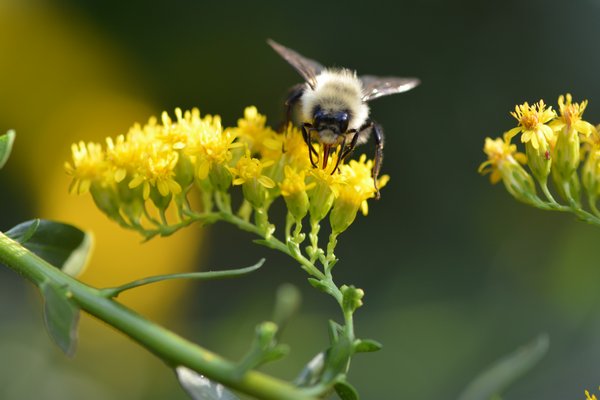
The White House issued a strategy in May to promote the health of honeybees and other important pollinators, called the Pollinator Research Action Plan.
And last week, at the Nature Conservancy in East Hampton, environmental horticulturist Kim Eierman, founder of the horticultural consulting company EcoBeneficial! and a horticultural teacher, spoke to gardeners and conservationists about concrete ways they can put that strategy into practice in their own backyards.
Pollinators are animals that move pollen from one part of a plant to another while collecting food. Pollination results in the plants making seeds or fruit, ensuring healthy reproduction. While some plants rely on air currents for pollination, animals account for pollination of 75 percent of our flowering plants and 35 percent of our food crops.
“A national project is absolutely essential to save pollinators,” Ms. Eierman said, “but the government can’t do it alone. A yard-by-yard initiative is in order to save pollinators.”
While the White House strategy focuses on honeybees and monarch butterflies as key species targeted for recovery, Ms. Eierman noted that these represent a tiny fraction of the pollinating population. On the East End alone, hundreds of species of beetles, flies, moths, butterflies, bees, wasps, bats and birds serve to pollinate our farm fields, flower gardens and fruit trees. Their survival is tied integrally to our own.
Unfortunately, the sprawling, perfect lawns replacing woodlands and farms across our landscape are, according to Ms. Eierman, “a green desert,” devoid of any benefit for pollinators.
“Look around,” she said last week. “You’ll see house after house with a lawn, some foundation landscaping, maybe a few over-story trees. If you’re a pollinator, what can you use in this landscape? This is pretty much ecological desert.
“If we don’t change the way that we landscape, the way that we garden, the way that we farm, the way that we live, we’re going to lose not only pollinators, but many other species,” she continued. “The youngest generation we have now may be the last generation to see monarch butterflies.”
Promoting what she calls “pollinator victory gardens,” a nod to the one million-plus victory gardens grown to combat food shortages during World War II, the horticulturist proposes the development of pollinator-friendly gardens in backyards and at churches, schools and community parks.
While the task may seem overwhelming, following a few simple principles can yield impressive results:
• Diversity rules! Plant as diverse a garden as you can manage in the space you have. Different pollinators have different needs, so the more varied your landscape, the more pollinator meals you’ll serve.
• Think long-term. Plant for a succession of blooms from early spring through fall.
• Don’t forget trees and shrubs. Many woody plants, such as red maples and dogwoods, provide not only an early spring food source, but also habitat for pollinators.
• Cut the lawn. A big green lawn is as American as apple pie and country music, but it’s an ecological wasteland. If you can’t bear to part with it entirely, think about replacing some of your lawn space with pollinator-friendly plantings.
• Stick with the basics. Avoid double-flowered plants and other fancy cultivars. The varieties created by nature generally have the most pollen and are the most accessible to pollinators.
• Include host plants. Butterfly bush is a great draw for all kinds of butterflies, but as a non-native plant, it doesn’t serve as a food source for growing butterfly larvae. For monarchs, plant milkweed. Other common host plants include dill, parsley, fennel, lamium, hollyhock and sunflowers.
• Leave it bare. Leave some areas of bare dirt on the edges of your yard for the 70 percent of native bees that nest in the ground.
• Go native. Native plants have evolved alongside native pollinators and are usually a good bet for being popular nectar and pollen sources.
• Create floral targets. Many pollinators are forage specialists, meaning they concentrate on one type of flower. Plant sizable clumps of a single species to make it easier for pollinators to find.
• Say no to sprays. Pollinators are very sensitive to fungicides, pesticides and herbicides, chemicals blamed in large part for the decline of both honeybees and monarchs. Even some organic sprays can be lethal. Introduce beneficial insects, like ladybugs and praying mantises, to control pests naturally. And learn to live with a little less perfection—but a lot more health—in the garden.
• Step away from the shears. It’s tempting to cut back perennials in the fall to make the yard tidy, but many pollinators rely on perennials to provide shelter over the winter. Hold off on pruning until spring.